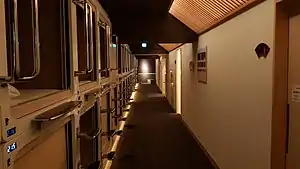Capsule hotel
Capsule hotel (Japanese: カプセルホテル, romanized: kapuseru hoteru), also known in the Western world as a pod hotel,[1] is a type of hotel developed in Japan that features many small bed-sized rooms known as capsules. Capsule hotels provide cheap, basic overnight accommodation for guests who do not require or who cannot afford larger, more expensive rooms offered by more conventional hotels.


The first capsule hotel in the world opened in 1979 and was the Capsule Inn Osaka, located in the Umeda district of Osaka, Japan and designed by Kisho Kurokawa.[2][3] From there, it spread to other cities within Japan. Since then, the concept has further spread to various other territories, including Belgium,[4] China,[5] Hong Kong,[6] Iceland,[7] India,[8] Indonesia,[9] Israel,[10] Poland, South Korea and Canada.
Description
The guest room is a chamber roughly the length and width of a single bed, with sufficient height for a hotel guest to crawl in and sit up on the bed. The chamber walls may be made of wood, metal or any rigid material, but are often fibreglass or plastic. Amenities within the room generally include a small television, air conditioning, an electronic console, and power sockets. The capsules are stacked side-by-side, two units high, with steps or ladders providing access to the second level rooms, similar to bunk beds. The open end of the capsule can be closed with a curtain or a solid door for privacy, but can be locked from the inside only.[11]

Like a hostel, many amenities are communally shared, including toilets, showers, wireless internet, and dining rooms. In Japan, a capsule hotel may have a communal bath and sauna. Some hotels also provide restaurants, snack bars, bars, or vending machines, pools, and other entertainment facilities. There may be a lounge with upholstered chairs for relaxing, along with newspapers and reading material.[12]
Capsule hotels vary in size, from 50 or so capsules to 700, and primarily cater to men.[13] Some capsule hotels offer separate sections for male and female guests, or even separate floors and elevators. Clothes and shoes are exchanged for a yukata and slippers on entry, and a towel and bathrobe may also be provided. Luggage and valuables are usually stored in lockers or—if available—in-room safes.[11] Guests are asked not to smoke or eat in the capsules.[14]
Customer base
The benefit of these hotels are their convenience and low price, usually around ¥2000–4000 (USD 18–36) a night.
In Japan, capsule hotels have been stereotypically used by Japanese salarymen who may be too drunk to return home safely, have missed the last train of the day to make a return trip home due to working late hours, or are too embarrassed to face their spouses.[15] During the Japanese Recession, some unemployed or underemployed workers who had become homeless during the crisis temporarily rented capsules by the month. As of 2010, these customers made up 30% of visitors at the Capsule Hotel Shinjuku 510 in Tokyo.[16]
See also
References
- "Pod Hotels: Small, Stylish, and Cheap". Fodors.com. December 31, 2007. Archived from the original on December 7, 2015. Retrieved March 9, 2012.
- "Capsule Inn Osaka" (in Japanese). Retrieved 24 December 2010.
- "Kotobuki Corporation History" (in Japanese). Kotobuki Corporation. Archived from the original on 2010-07-24. Retrieved 24 December 2010.
- "Trend alert: Belgium opens Europe's first capsule hotel". CTV News. 2014-09-26. Retrieved 2016-06-10.
- "China's first capsule hotel opens in Xi'an". Cnngo.com. CNN Travel. 2012-05-14. Archived from the original on 2012-10-30. Retrieved 2012-11-30.
- "Sleep – Hong Kong's first capsule hotel". Perspective Global. 2017-01-27. Retrieved 2017-02-15.
- "Svefnhylki komin á hótelmarkaðinn". Retrieved 2016-06-25.
- "With 50 sq ft, India's first pod hotel opens in Mumbai". dna. 3 March 2017. Retrieved 3 March 2017.
- "Kamar Kapsul TAB Hotel Kini Hadir di Kayoon Surabaya, Cukup Bayar Segini Sudah Dekat Pusat Kota!". Tribun Jatim. 17 September 2017. Retrieved 26 November 2018.
- "רשת המלונות החדשה שמציעה חדרים ב-99 שקלים ללילה". Israel Hayom. 28 November 2022. Retrieved 4 December 2022.
- Morrison, Geoffrey (24 July 2016). "What It's Like To Stay At A Japanese Capsule Hotel". Forbes. Retrieved 29 December 2018.
- Schreiber, Mark (January 16, 2001). "Back to the future of a 'hotel for 2001'", The Japan Times, pp. 7–8.
- "Accommodation in Japan". Japan-guide.com. 2012-11-11. Retrieved 2012-11-30.
- Solomon, Leonard (1997). Japan in a Nutshell. Top Hat Press, 115–166. ISBN 0-912509-06-6.
- Wardell, Steven (October 1994). "Capsule cure". Atlantic Monthly. 274 (4):42–47.
- Tabuchi, Hiroko. "For Some in Japan, Home Is a Tiny Plastic Bunk", The New York Times, 2010-01-01. Retrieved on 2010-01-18.